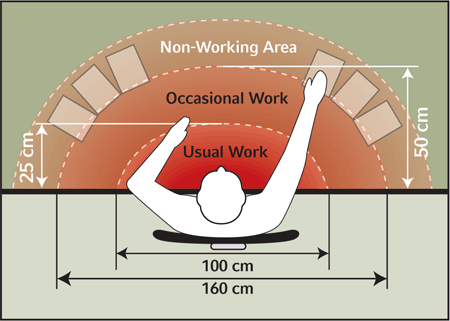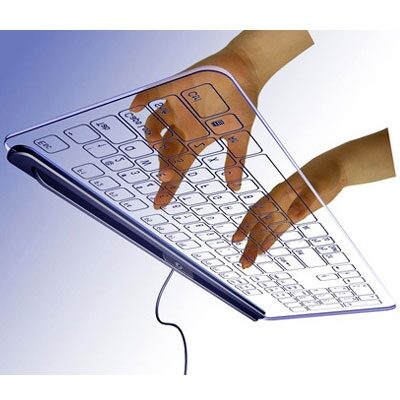THE DESIGN AND LAYOUT OF AN AMATEUR RADIO STATION MADE EASY (ERGONOMICS FOR THE HAM SHACK) WHAT IS ERGONOMICS?
Ergonomics is the science of designing equipment and work spaces for maximum efficiency at a minimum of operator discomfort and fatigue. The word ergonomics comes from combining two Greek words that mean “working naturally”. In other words, something that is ergonomically designed is a pleasure to use.
However, be wary of today’s advertising pitches that throw the word ergonomic around very casually. Splitting a computer keyboard in half does not necessarily make it easier to use or more efficient!
We are usually told that there is just one optimum ergonomic layout that is correct. WRONG! It is unfortunate, but true, that what we read now days in text books or on the Internet – or even what we are told by our doctor – has generally not kept up with the latest scientific studies. The good news is that the ridged rules of the past have recently become much more relaxed. With these rigid ergonomic rules from the good old days changing, you can now feel free to see what works best for your own particular situation.
Most of us have already discovered good ergonomics by the application of the old trial and error method – we learn from our mistakes. Further, most of us already apply most of what we have learned to our ham shack layout. However, you might still be able to pick up a few useful tidbits by reading the following review of what is currently considered to be good ergonomics.
WHY CONSIDER AN ERGONOMIC LAYOUT?
Keep in mind that the goal is to feel good when you sit down to your operating location. This feeling of comfort and well being will come naturally if your ham shack operating location is well thought out and implemented.
Generally, if you operate your station continuously for one hour or more a day, it is best if your layout fits certain general ergonomic principals. Good practices here will help minimize eye strain as well as the back and muscle pain that many of us older folks experience. It will not, however, help with the pain in the butt that is caused by some operators that we encounter on the ham bands.
A BASIC ERGONOMIC LAYOUT
In the simplest of terms, if you use a limited number of transceivers, receivers, transmitters and monitors, the workspace layout should be U-shaped with the most used items within each reach. A corner layout is great if you have a corner available in your shack. If you are like me and don’t have a corner, you can use an extra deep desk top which will provide enough space for a U-shaped arrangement to be created. It is generally best to place your equipment symmetrically on both sides
of your seating position. Check your layout by sweeping each arm around the space in front of you. You should be able to reach most of the frequently used knobs and switches without leaning forward or leaning sideways too much. Equipment should usually not be stacked over about 18 inches in height due to operator reach limitations.
Some hams even set up separated workstations for different groups of equipment. This allows them to maintain good ergonomics even though they have more equipment than can be arranged into a single U-shaped configuration.
The desktop surface height above the floor should usually be around 28 to 30 inches although this can be varied somewhat in relationship to your individual height and preferences. I like mine a little lower.
It is also a common practice to include a generous compliment of shelves located above your primary U-shaped equipment layout which can be used to store the less often used equipment and supplies.
The fronts of your equipment should be tilted up so that the dials and button labels are easier to read. For equipment without some sort of flip down front riser, you can use a short length of 2 x 2 or equivalent to do the job. Although an angle of 90 degrees to your line vision provides the best front panel view, it is not the best angle for turning the knobs. I like to be able to turn the knobs with most of my forearm resting on the desktop surface. This places the main tuning knob centerline 3 to 4 inches above the desktop while still providing a reasonable front panel viewing angle. Equipment lighting is also very important and we’ll get into that subject later.
LOCATING THE MONITOR SCREEN
Conventional wisdom is that the monitor should be placed straight ahead of you and should be 18 to 24 inches from your eyes. Straight ahead is still the optimum location for your monitor. However the best distance is now considered to be farther away, limited only by your ability to read the screen. This longer distance tends to relax the eyes, creates less eye strain and produces significantly less neck pain.
It is also now recommended that the monitor height should be quite low. It is best for most people if the monitor is resting directly on the surface of the work table. The top of the monitor screen should be set to be well below eye level if possible. The screen should also be angled so that there is no glare on the screen either from the general room lighting, from the task lighting or from the outside windows. Typically, for easiest reading of the screen,
the monitor screen should be about 10 times brighter that the surrounding light level.
You might also need to consider task-specific eye glasses. Often people over the age of 40 get presbyopil (Greek for old man’s eyes) where we lose our ability to focus on objects that are near to us.
THE KEYBOARD
You can place the keyboard directly in front of you if this is your most used item. However, if like most hams, you do more writing than typing, it makes more sense for you to place your pad of paper in front of you and place the keyboard at an angle off to one side. The mouse should be at the side of the keyboard. This minimizes the keyboard- to-mouse travel time and lets you locate the mouse quickly without having to looking for it.
Since table surface is at a premium in my shack, my keyboard is mounted on a slide-out tray this is under the desktop. It is mounted a close under the table as possible so that it is at the correct height when it is pulled out for use. This slide out is 36 inches wide so that it also carries the mouse and a pencil tray full of items that would normally clutter up the work surface.
Wherever you place your keyboard, you should be still be able to keep your wrists straight when typing. The keyboard angle should more or less match your forearm angle. Note that it is still considered true that the wrists should remain straight if possible. The occasional use of wrist rests is also currently considered to be acceptable as long as they are not used continuously.
If you want to try a split keyboard, get one with a hinged middle so that you can gradually adapt to it. Note that the are usually much more expensive and that the benefits have not yet been proven. However, some people like them and they are certainly not harmful – except to your pocket book.
ERGONOMIC CHAIR DESIGN
Try to find chair with a design that is based on ergonomic principals. Remember that a chair will be ergonomic only if it fits you correctly.
A good ergonomic chair design will provide a wide range of seat height and depth adjust ability, 3-way backrest adjustments plus armrest adjust ability as well as lumbar support adjustments. The chair should have five sturdy legs on a sturdy base for stability and should roll around smoothly and easily. This allows you to achieve the correct operating position without it becoming a chore. Smooth swiveling allows you to teach further to the sides without twisting your back. The chair seat should be set low enough so that your feet can reach the floor, even when somewhat extended. The chair that I use is a knockoff of a famous brand name and cost me less than $200 on sale instead of $800 to $1,500. My chair also has arm rests that can be raised up out of the way which adds more variety to the possible
seating positions, especially when I am doing a lot of typing.
USING A FOOTREST
A footrest is often useful and allows you to vary your leg position from time to time. You should not, however, be forced to keep both of your feet on the footrest for a prolonged period. I often use a floor switch to control the transmitter while maintaining sufficient space on both sides of my footrest in order to allow the widest possible variety of leg positions.
THE LATEST POSTURE GUIDELINES
As you already know, a 90 degree upright posture used to be the golden rule. However, the latest research studies have revealed that an angle of up to 120 degrees or so can be more optimum for many people. This angle reduces the pressure on the inververtebral discs and requires less work to be performed by the lower back muscles by allowing the chair back to support a portion of the body weight. This new posture standard may require a different kind of chair than you are used to in order to secure the necessary support lumbar. While this posture may not be comfortable for all people, it is now considered to be OK if you like to recline a little.
Also, the 90 degree knee angle that used to be recommended is no longer considered sacred. The legs should be moved often since the ability to change positions frequently and conveniently is now thought to be just as important as posture correctness.

TAKE FREQUENT REST BREAKS
It is important to take frequent rest breaks. A 30 second brake every 10 minutes or so is much better than a longer break every hour or so. This fits very with the normal rhythm of ham radio operating procedures and is a no-cost ergonomic improvement.
For variety, you can occasionally operate from a standing position. I find that this provides a nice rest break even while I am continuing to operate the station. Since I usually use a Heil pro elite headset, operating while standing is very easy to do. For variety, I also sometimes use wireless earphones with a boom mounted microphone. The wireless earphones have an additional advantage that I can leave the shack and still listen for my turn to come up on the net.
VOICE RECOGNITION SOFTWARE
If you don’t like to type or write, you might consider using voice recognition software. I use Dragon Naturally Speaking software and have found that it particularly useful when rag chewing while using the digital modes (since neither my typing speed or my accuracy are very good).
WHAT IS THE CORRECT LIGHTING?
Correct lighting very is important. Poor lighting can strain the eyes, cause eye discomfort (burning) and can even cause headaches. In fact, lighting is such a big deal that Herman Miller of ergonomic chair fame has recently teamed up with LUXO for “health protecting lighting”. The latest advertising buzz that I hear says that special lighting will even improve your mood and energy level. Watch out, here comes the $500 desk lamp.
Lighting is a sufficiently complicated subject that it would take a book long treatment to get it all said. However, I will try to boil down the ergonomic fundamentals to a couple of short paragraphs.
As luck would have it, the lighting of a ham station operating location is not too difficult, and it does not need to be complicated or expensive. You should consider two kinds of lighting to do it right – one is general room lighting and second kind of lighting that is called task lighting. Most of us already have general room lighting that works. However, you might want to tune it up a little to make it brighter, more uniform and more shadow free.
While the general lighting should be made to be sufficiently bright and shadow free to allow easy reading of equipment knobs, dials and computer monitors, the immediate work area that is in front of you should be somewhat brighter. Reading and writing of paper documents actually requires as much as 5 times more light than the general lighting level. This additional light is often called task lighting and can be provided by a properly positioned desk lamp or even a near by floor lamp. This task light source should be sufficiently bright without producing glare, should have the right color balance, should be diffuse (shadow free) and should be easily positioned according to the task at hand.
In the shack, my general lighting is provided by six halogen can-style ceiling lights with their brightness adjustable by a wall mounted dimmer. This lighting is very uniform throughout the room and has nice color but is not completely shadow free. On the other hand, my wife’s sewing room uses four 4-foot long diffused lighting fixtures that are fitted with broad spectrum fluorescent tubes. This lighting setup provides lots of light, yields excellent color reproduction and is extremely uniform as well as being completely shadow free. Her general lighting is far superior to mine.
For task lighting, I use an ancient OTT floor lamp which stands at the right of my operating position. This lamp has very nice color balance (read color rendering) and puts a very uniform light onto my desktop whenever it is needed. Although I do not usually use task lighting for normal operation, the lamp great for reading and for working on the occasional small components.
LED lighting is the new wild card in the field and should be considered for both general and task lighting applications. However, be aware that the LED lights themselves operate at low voltages and often use switching power supplies when used on conventional 120 volts AC house power. These power supplies have the potential to produce a lot of very annoying radio noise! Note that some Internet routers will also make a lot of noise in the ham bands and may have to be located as far as possible from your antennas or even replaced.
TRY IT – YOU WILL LIKE IT
Finally, hams have always been known to do the best they can with what they have – and without complaint. Almost every ham shack layout that I have seen has some compromises, including mine.
However, if you want to make your shack work a little better, simply prioritize what matters the most to you and incorporate as many good ergonomic principals as you can.
You will enjoy your shack more!
Source: w6sdo.com



